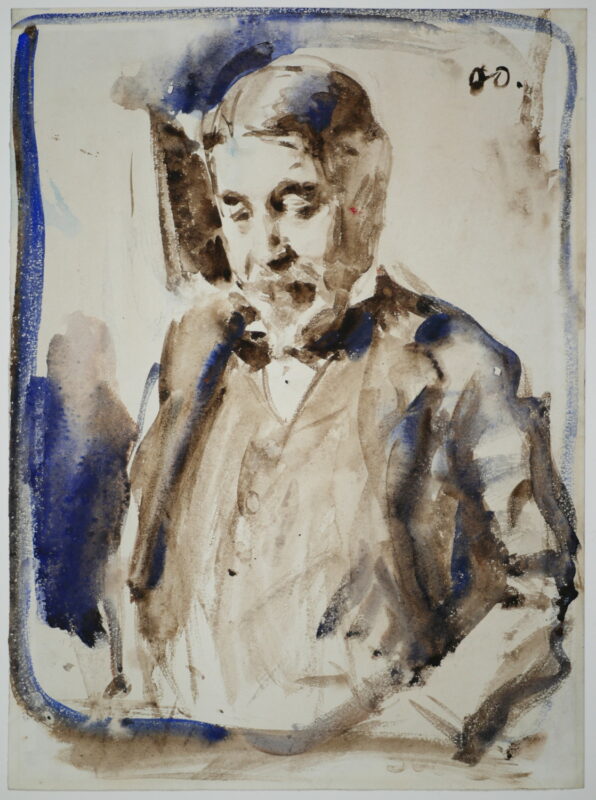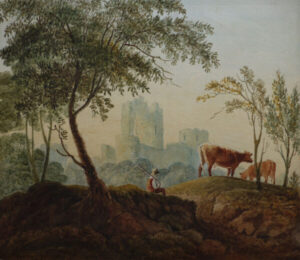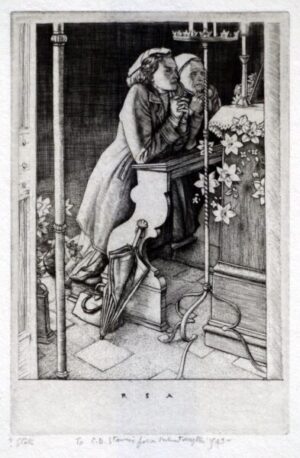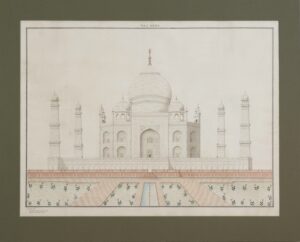Oppenheimer, Joseph (1876-1966)
Joseph Oppenheimer was born in Würzburg Germany on July 13th 1876. From an early age, his whole life was art. At 15, before being old enough to enrol in the Munich Academy of Art, he left school and began studying art with some of the foremost German painters such as Fehr. Perhaps the impetus for this was his chance meeting with The Iron Chancellor, Otto von Bismarck, at the age of 14 when they both stayed at the same spa hotel. Joseph made a pencil sketch of Bismarck and presented it to him. Bismarck returned the drawing with a handwritten and signed note of congratulations, which Oppenheimer kept with him the rest of his life.
At 16 Joseph Oppenheimer was admitted to the Munich Academy. From 19 to 25 he was studying in Rome, Naples, London and New York and had also travelled as far afield as Egypt with his uncle August Schwabacher and his cousin Hedwig, during which he met and painted a portrait of Cecil Rhodes. In the USA, where he had a studio for six months in 1900-01, he painted many well-known people and scenes, including Generals MacDonald Moody and Grenville M. Dodge, and spent time in Lake George with the famous photographer Alfred Stieglitz. He painted members of the family of art dealer and patron Asher Wertheimer, the same family as had also John Singer Sargent. He befriended the famous American painter, as well as James Whistler, and was able to persuade them to take part in the Berlin Secession - the German Impressionist Exhibition – 1899-1902. He was chosen to paint a portrait of Richard Canfield, who was also being painted by Whistler at that time. This was a great honour.
Joseph Oppenheimer already had a studio, the Pheasantry on King’s Rd. in London as from 1896. He taught at the London School of Arts. He became a member of the famous Chelsea Arts Club. He also spent much time and exhibited in Germany, and even also had a studio in Berlin in 1902 for a few months. He was promoted by such famous art dealers as Paul Cassirer.
In 1907 Joseph Oppenheimer was elected a member of the International Society of Sculptors, Painters and Gravers and agreed to teach art at the London School of Art.
In 1908, when he married Fanny, his second cousin, he gave up his London studio and moved to Berlin. He never gave up his love for England, the English countryside and the English people, He and Fanny honeymooned near Henley, on the Thames, and they spent part of every year in England. He was especially fond of the Thames River and painted many pictures especially of Henley, Surbiton, the grand English country Manors and English scenery, interior scenes and London itself.
Both in England and in Germany Joseph Oppenheimer became more and more renowned for his paintings and especially his portraits, Famous men and women, and especially beautiful ladies from High Society throughout Europe, but especially in Germany and England, lined up to be painted, even during the German economic recession. Many of his most successful works graced the covers of the ladies' magazines in both countries. He exhibited at the Royal Academy and at the Royal Society of Portrait Painters, becoming a member of the latter, allowing him to use R.P. after his name (he was offered Doctorates many times and even a Professorship, but refused them all). He did, however, accept an Honourable Mention from the International Exhibition of the Carnegie Institute in Pittsburg, a gold medal at the 10th Munich International Exhibition in 1910, and a bronze medal at the Barcelona International Exhibition.
At the same time as his many portrait commissions - including Einstein in 1931 - he was a prolific sketcher and a painter of landscapes and flowers.
Much of Joseph Oppenheimer’s portraiture fame came from his unique style of combining close observation and faithful reproduction of a sitter’s features with a looser, more impressionistic approach to the treatment of the model’s clothing and of the background.
In early 1933, after Hitler came to power, and focused his ire on both Jewish and “avant-garde” art, the Oppenheimers chose to once again live permanently in London. Shortly after returning permanently to London, he was elected a member of the Royal Society of Portrait Painters. Luckily Fanny was able to return to Germany several times before the outbreak of WWll and get out just about all – but not all - of their possessions and artwork. They became British citizens in 1936, having been sponsored by the equerry of King George VI, Sir Louis Greig, and a famous British artist, Sir John Lavery.
Joseph Oppenheimer continued his painting and his career in London, notwithstanding the Depression, living comfortably in St. John's Wood, on a street where subsequently one of the Beetles lived. After 1949, when his daughter Eva and her family moved to Canada, he sold that house and spent half of each year in Montreal and New York, and the other half in London, always travelling in style on the beautiful ocean liners of Canadian Pacific, Cunard or Home Lines. During summer holidays he spent several months with Fanny and the Pragers in Rockport, Mass. and Provincetown, painting every day. His works were exhibited in Galleries and Museums on both sides of the Atlantic.
In July 1966 Joseph Oppenheimer returned to London for the last time, to celebrate his 90th birthday. A few weeks later he took his first transatlantic jet flight, back to Montreal, where he died shortly after, on August 31st. He painted until just a couple of days before his death.
Joseph Oppenheimer painted many famous people including Albert Einstein, Sir Harold MacMillan, Count Otto Von Bismarck, President Kruger of South Africa, Mayor of Montreal Camillien Houde, Deborah Kerr, and countless famous men and women of stage and screen in England and the USA.



